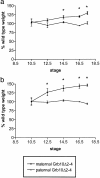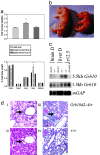Disruption of the imprinted Grb10 gene leads to disproportionate overgrowth by an Igf2-independent mechanism
- PMID: 12829789
- PMCID: PMC166222
- DOI: 10.1073/pnas.1532175100
Disruption of the imprinted Grb10 gene leads to disproportionate overgrowth by an Igf2-independent mechanism
Abstract
To investigate the function of the Grb10 adapter protein, we have generated mice in which the Grb10 gene was disrupted by a gene-trap insertion. Our experiments confirm that Grb10 is subject to genomic imprinting with the majority of Grb10 expression arising from the maternally inherited allele. Consistent with this, disruption of the maternal allele results in overgrowth of both the embryo and placenta such that mutant mice are at birth approximately 30% larger than normal. This observation establishes that Grb10 is a potent growth inhibitor. In humans, GRB10 is located at chromosome 7p11.2-p12 and has been associated with Silver-Russell syndrome, in which approximately 10% of those affected inherit both copies of chromosome 7 from their mother. Our results indicate that changes in GRB10 dosage could, in at least some cases, account for the severe growth retardation that is characteristic of Silver-Russell syndrome. Because Grb10 is a signaling protein capable of interacting with tyrosine kinase receptors, we tested genetically whether Grb10 might act downstream of insulin-like growth factor 2, a paternally expressed growth-promoting gene. The result indicates that Grb10 action is essentially independent of insulin-like growth factor 2, providing evidence that imprinting acts on at least two major fetal growth axes in a manner consistent with parent-offspring conflict theory.
Figures





Similar articles
-
Maternally-inherited Grb10 reduces placental size and efficiency.Dev Biol. 2010 Jan 1;337(1):1-8. doi: 10.1016/j.ydbio.2009.10.011. Epub 2009 Oct 13. Dev Biol. 2010. PMID: 19833122
-
Imprinting of human GRB10 and its mutations in two patients with Russell-Silver syndrome.Am J Hum Genet. 2000 Aug;67(2):476-82. doi: 10.1086/302997. Epub 2000 Jun 12. Am J Hum Genet. 2000. PMID: 10856193 Free PMC article.
-
Duplication of 7p11.2-p13, including GRB10, in Silver-Russell syndrome.Am J Hum Genet. 2000 Jan;66(1):36-46. doi: 10.1086/302717. Am J Hum Genet. 2000. PMID: 10631135 Free PMC article.
-
Grb10 exceeding the boundaries of a common signaling adapter.Front Biosci. 2004 Jan 1;9:603-18. doi: 10.2741/1227. Front Biosci. 2004. PMID: 14766395 Review.
-
Grb10: more than a simple adaptor protein.Front Biosci. 2004 Jan 1;9:387-403. doi: 10.2741/1226. Front Biosci. 2004. PMID: 14766376 Review.
Cited by
-
Dysregulation of methylation and expression of imprinted genes in oocytes and reproductive tissues in mice of advanced maternal age.J Assist Reprod Genet. 2015 May;32(5):713-23. doi: 10.1007/s10815-015-0463-9. Epub 2015 Mar 24. J Assist Reprod Genet. 2015. PMID: 25800995 Free PMC article.
-
Nedd4 controls animal growth by regulating IGF-1 signaling.Sci Signal. 2008 Sep 23;1(38):ra5. doi: 10.1126/scisignal.1160940. Sci Signal. 2008. PMID: 18812566 Free PMC article.
-
Brain-derived neurotrophic factor modulation of Kv1.3 channel is disregulated by adaptor proteins Grb10 and nShc.BMC Neurosci. 2009 Jan 23;10:8. doi: 10.1186/1471-2202-10-8. BMC Neurosci. 2009. PMID: 19166614 Free PMC article.
-
Inheritance of paternal lifestyles and exposures through sperm DNA methylation.Nat Rev Urol. 2023 Jun;20(6):356-370. doi: 10.1038/s41585-022-00708-9. Epub 2023 Jan 18. Nat Rev Urol. 2023. PMID: 36653672 Review.
-
Dual ablation of Grb10 and Grb14 in mice reveals their combined role in regulation of insulin signaling and glucose homeostasis.Mol Endocrinol. 2009 Sep;23(9):1406-14. doi: 10.1210/me.2008-0386. Epub 2009 Jun 18. Mol Endocrinol. 2009. PMID: 19541746 Free PMC article.
References
Publication types
MeSH terms
Substances
LinkOut - more resources
Full Text Sources
Molecular Biology Databases
Miscellaneous

